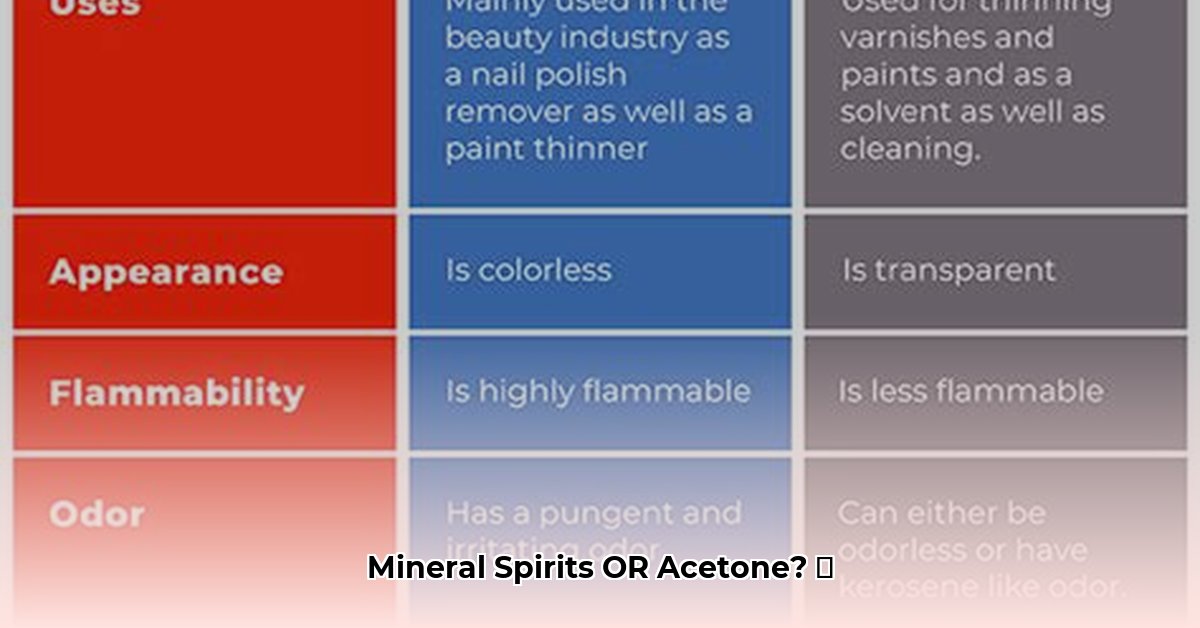Solvent Showdown: Mineral Spirits vs. Acetone
Choosing the right solvent can be tricky. This guide breaks down the differences between mineral spirits and acetone, helping you select the best one for your project while prioritizing safety and eco-friendliness.
Mineral Spirits: The Oil-Based Expert
Mineral spirits, derived from petroleum, are the go-to for oil-based projects. They excel at thinning oil-based paints, varnishes, and cleaning brushes caked with stubborn residue. Think of them as the gentle giant of solvents—strong enough for the task, but less aggressive than acetone. Low-odor versions are available, minimizing the harsh smell. However, even odorless mineral spirits require proper ventilation. They are highly effective on oil-based products but should not be used with latex paints. Some plastics may dissolve with prolonged exposure, so test in an inconspicuous area first.
Pros:
- Effective on oil-based paints, varnishes, and stains
- Available in low-odor versions
- Dissolves grease and sticky residues
Cons:
- Flammable
- Can irritate skin and airways
- Not suitable for latex paints or some plastics
Acetone: The Powerhouse Dissolver
Acetone, a naturally occurring and manufactured organic compound, is a potent solvent. It tackles tough jobs like dissolving two-part epoxy, super glue, dried latex paint, and some inks. Think of it as the superhero solvent, ready to tackle the most stubborn substances. However, this power comes with responsibility. Acetone has a pungent odor, is highly flammable, and can damage some plastics. Always test in a hidden area first.
Pros:
- Dissolves a wide range of substances
- Evaporates quickly
- Effective for stubborn adhesives and inks
Cons:
- Highly flammable
- Strong, potentially irritating odor
- Can damage some plastics
- Toxic if swallowed
Mineral Spirits vs. Acetone: A Head-to-Head Comparison
| Feature | Mineral Spirits | Acetone |
|---|---|---|
| Source | Petroleum-derived | Naturally occurring and manufactured (organic compound) |
| Best Use | Oil-based paints, varnishes, cleaning brushes | Glues, epoxy, resins, some paints, nail polish |
| Odor | Strong (odorless versions available) | Strong, pungent |
| Flammability | High | Very High |
| Evaporation Rate | Slow | Fast |
| Water Soluble | No | Yes |
| Common Applications | Thinning oil-based paints, cleaning brushes, removing wax | Dissolving epoxy, super glue, nail polish, thinning lacquer |
Safe Handling of Solvents: A Priority
Both mineral spirits and acetone are flammable and release potentially harmful vapors. Always work in a well-ventilated area, preferably outdoors. Wear appropriate personal protective equipment:
- Gloves: Nitrile gloves are generally suitable for mineral spirits; neoprene gloves are recommended for acetone. Always check manufacturer guidelines.
- Eye Protection: Safety glasses or goggles are essential.
- Respirator: For larger projects or confined spaces, a respirator with an organic vapor cartridge is highly recommended.
Eco-Friendly Alternatives: A Greener Approach
Consider environmentally friendly alternatives like citrus-based solvents for cleaning or water-based paint strippers for removing paint. While these may not be as powerful for all tasks, they offer a gentler approach for you and the environment. Ongoing research continually explores new, eco-conscious solvent options.
Disposal: Protect Our Planet
Never pour solvents down the drain. Improper disposal contaminates water sources and harms the environment. Consult your local waste disposal facility for guidelines. They can advise on safe and responsible disposal methods, including designated collection events for hazardous household waste.
Choosing the Right Solvent: The Deciding Factor
The best solvent depends on your project. For oil-based projects, mineral spirits are the reliable choice. For dissolving stubborn substances like glues and epoxy, acetone is the go-to. Choose wisely, work safely, and dispose responsibly.
FAQs: Clearing Up Common Queries
- Can I mix mineral spirits and acetone? Generally not recommended. They have different chemical properties and may not interact well.
- Is acetone the same as nail polish remover? Most nail polish removers contain acetone, but they may also include other ingredients. Pure acetone is more potent.
Delving Deeper (Optional): The Science of Solvents
Mineral spirits are a mixture of aliphatic and alicyclic hydrocarbons. Acetone, also known as propanone, is a simple ketone. These different chemical structures explain their varying solvent properties and why they’re effective for different tasks. Ongoing research continues to explore the complexities of these solvents and their interactions with various materials.
- Backsplash For Gray Cabinets: Choosing the Right Backsplash Style - December 13, 2025
- Gray And White Backsplash: Ideas For Timeless Style - December 12, 2025
- Gray Kitchen Backsplash Ideas: Find Your Perfect Gray Tile - December 11, 2025









